.

A Scene from The Beggar's Opera, Act V: William Hogarth, 1728-1729, oil on canvas, 51 x 61 cm (National Gallery of Art, Washington, D.C.)
Act Three. Scene 13. The Condemn'd Hold
MACHEATH, in a melancholy Posture.
Air LXVII.--Green Sleeves.
Since Laws were made for ev'ry Degree,JAILOR. Some Friends of yours, Captain, desire to be admitted----I leave you together.
To curb Vice in others, as well as me,
I wonder we han't better Company,
Upon Tyburn Tree!
But Gold from Law can take out the Sting;
And if rich Men like us were to swing,
'Twould thin the Land, such Numbers to string
Upon Tyburn Tree!
Scene 14. MACHEATH, BEN BUDGE, MATT OF THE MINT.
MACHEATH. For my having broke Prison, you see, Gentlemen, I am order'd immediate Execution.----The Sheriff's Officers, I believe, are now at the Door.----That Jemmy Twitcher should peach me, I own surpris'd me!----'Tis a plain Proof that the World is all alike, and that even our Gang can no more trust one another than other People. Therefore, I beg you, Gentlemen, look well to yourselves, for in all probability you may live some Months longer.
MATT. We are heartily sorry, Captain, for your Misfortune.----But 'tis what we must all come to.
MACHEATH. Peachum and Lockit, you know, are infamous Scoundrels. Their Lives are as much in your Power, as yours are in theirs.---- Remember your dying Friend!----'Tis my last Request.----Bring those Villains to the Gallows before you, and I am satisfied.
MATT. We'll do it.
JAILOR. Miss Polly and Miss Lucy intreat a Word with you.
MACHEATH. Gentlemen, adieu.
Scene 15. LUCY, MACHEATH, POLLY.
MACHEATH. My dear Lucy----My dear Polly. Whatsoever hath pass'd between us is now at an end----if you are fond of marrying again, the best Advice I can give you is to Ship yourselves to the West-Indies, where you'll have a fair Chance of getting a Husband a-piece, or by good Luck, two or three, as you like best.
POLLY. How can I support this Sight!
LUCY. There is nothing moves one so much as a great Man in Distress.
Air LXVII.----All you that must take a Leap, & c.
LUCY.
LUCY.
Would I might be hang'd!POLLY.
And I would so too!LUCY.
To be hang'd with you.POLLY.
My dear, with you.MACHEATH.
O leave me to Thought! I fear! I doubt!POLLY.
I tremble! I droop!----See, my Courage is out! [Turns up the empty Bottle.]
No Token of Love?MACHEATH.
See, my Courage is out. [Turns up the empty Pot.]LUCY.
No Token of Love?POLLY.
Adieu.LUCY.
Farewell.MACHEATH.
But hark! I hear the Toll of the Bell.CHORUS.
Tol de rol lol, &c.JAILOR. Four Women more, Captain, with a Child apiece! See, here they come. [Enter Women and Children.]
MACHEATH. What----four Wives more!----This is too much----Here----tell the Sheriff's Officers I am ready. [Exit Macheath guarded.]
Scene 16. To them, Enter PLAYER and BEGGAR.
PLAYER. But, honest Friend, I hope you don't intend that Macheath shall be really executed.
BEGGAR. Most certainly, Sir.----To make the Piece perfect, I was for doing strict poetical Justice----Macheath is to be hang'd; and for the other Personages of the Drama, the Audience must have suppos'd they were all hang'd or transported.
PLAYER. Why then Friend, this is a downright deep Tragedy. The Catastrophe is manifestly wrong, for an Opera must end happily.
BEGGAR. Your Objection, Sir, is very just, and is easily remov'd. For you must allow, that in this kind of Drama, 'tis no matter how absurdly things are brought about----So----you Rabble there----run and cry, A Reprieve! ----let the Prisoner be brought back to his Wives in Triumph.
PLAYER. All this we must do, to comply with the Taste of the Town.
BEGGAR. Through the whole Piece you may observe such a Similitude of Manners in high and low Life, that it is difficult to determine whether (in the fashionable Vices) the fine Gentlemen imitate the Gentlemen of the Road, or the Gentlemen of the Road, the fine Gentlemen.----Had the Play remain'd, as I first intended, it would have carried a most excellent Moral. 'Twould have shown that the lower sort of People have their Vices in a degree as well as the Rich: And that they are punish'd for them.
John Gay (1685-1732): from The Beggar's Opera (1728)


Lavinia Fenton (1710-1760), later Duchess of Bolton, as Polly Peachum in John Gay's The Beggar's Opera: Charles Jervas (1675-1739), 18th c., oil on canvas, 127 x 102.8 cm (Christie's)
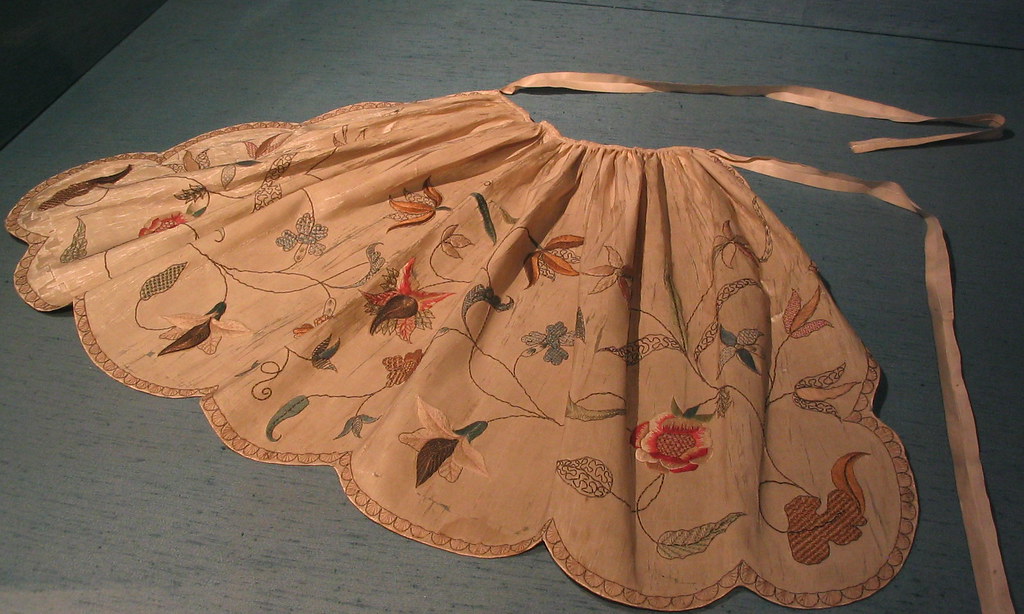
Apron worn by Lavinia Fenton in originating the role of Polly Peachum in John Gay's The Beggar's Opera, 1728: photo by Lauren, 12 January 2005

Finale scene from Robert Wilson production of The Threepenny Opera (Die Dreigoschenoper), Berlin 2008: photo by Colya Kärcher (via Susan Berenofsky: The Berlin Blog)
"Swift's first conception of it -- the pastoral method applied to Newgate"
___
"There is a natural connection between heroic and pastoral before they are parodied, and this gives extra force to the comic mixture. Both when in their full form assume or preach what the parody need not laugh at, a proper or beautiful relation between rich and poor. Hence they belong to the same play -- they are the two stock halves of the double plot.
"Clearly it is important for a nation with a strong class system to have an art-form that not merely evades but breaks through it, that makes the classes feel part of a larger unity or simply at home with each other. This may be done in odd ways, as well by mockery as admiration. The half-conscious purpose behind the magical ideas of heroic and pastoral was being finely secured by the Beggar's Opera when the mob roared its applause both against and with the applause of Walpole.
"One of the traditional ideas at the back of the hero was that he was half outside morality, because he must be half outside his tribe in order to mediate between it and God, or it and Nature.... This in a queer way was still alive in the theatre; the perversion of human feeling might not be justified in the Restoration tragic hero, because he was so ideal, and the Restoration comic hero was a rogue because he was an aristocrat. The process of fixing these forms into conventions, the Tragedy of Admiration and the comedy of the predatory wit, undertaken because the former had come to seem unreal, for some reason brought out their primitive ideas more sharply. Now on the one hand, this half-magical view seemed to the Augustans wicked as well as ridiculous; all men were men; they had just put down the witch-burnings; to a rational pacifism Marlborough and Alexander were bullies glorified by toadies. On the other hand, they were Tory poets, and the heroic tradition, always royalist (the King's divine right made the best magical symbol), had died on their hands. The only way to use the heroic convention was to turn it into the mock-hero, the rogue, the man half-justified by pastoral, and the only romance to be extracted from the Whig government was to satirise it as the rogue. The two contradictory feelings were satisfied by the same attitude.
"The rogue so conceived is not merely an object of satire; he is like the hero because he is strong enough to be independent of society (in some sense), and can therefore be the critic of it..."
___
"I should say then that the essential process behind the Opera was a resolution of heroic and pastoral into a cult of independence. But the word is capable of great shift of meaning, chiefly because nobody can be independent altogether; Gay meant Peachum to be the villain, and there is a case for thinking him more independent than Macheath; the animus against him seems more than that due to a traitor; Gay dislikes him as a successful member of the shopkeeping middle class, whereas Macheath is either from a high class or a low one..."
William Empson: from The Beggar's Opera: Mock Pastoral as the Cult of Independence in Some Versions of Pastoral, 1935

Lavinia Fenton (1710-1760), later Duchess of Bolton, as Polly Peachum in John Gay's The Beggar's Opera: Charles Jervas (1675-1739), 18th c., oil on canvas, 127 x 102.8 cm (Christie's)

Apron worn by Lavinia Fenton in originating the role of Polly Peachum in John Gay's The Beggar's Opera, 1728: photo by Lauren, 12 January 2005
An execution outside Newgate Prison: Thomas Rowlandson, between 1805 and 1810, ink and watercolour over pencil

The Beggar's Opera: print by Thomas Rowlandson, n.d. (via Grub Street EC2)

The infamous outlaw Jack Sheppard, thought to be the "original" of John Gay's Captain MacHeath, pointing to the door of his cell, plotting another daring escape: engraving by George White, based on a painting by James Thornhill made while the subject awaited execution in Newgate Prison, 1728; plate from Christopher Hibbert, The Road to Tyburn, 1957; image by Geogre, 4 February 2007
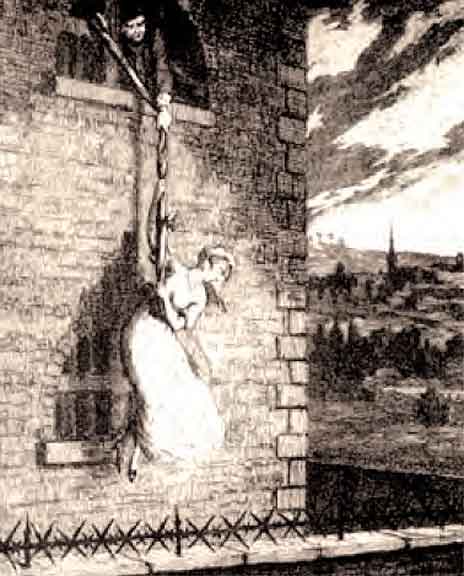
Jack Sheppard uses a rope of knotted bedclothes to lower his mistress Bess Lyon during their escape from New Prison in Clerkenwell, 25 May 1724: artist unknown
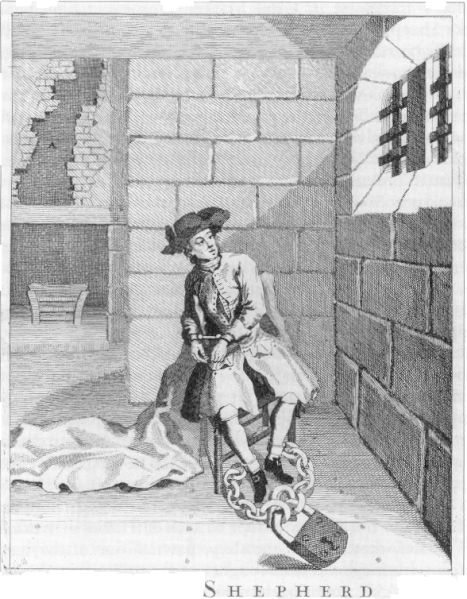
Jack Sheppard, notorious outlaw thought to have been the model for John Gay's MacHeath in The Beggar's Opera, in Newgate Prison before his fourth escape; the label "A" in the brickwork at rear marks the hole Sheppard made in the chimney during his escape: anonymous frontispiece drawing from the Narrative of Jack Sheppard's Life, published by John Applebee in 1724; image by RetiredUser2, 29 January 2007

Jack Sheppard uses a rope of knotted bedclothes to lower his mistress Bess Lyon during their escape from New Prison in Clerkenwell, 25 May 1724: artist unknown

Jack Sheppard, notorious outlaw thought to have been the model for John Gay's MacHeath in The Beggar's Opera, in Newgate Prison before his fourth escape; the label "A" in the brickwork at rear marks the hole Sheppard made in the chimney during his escape: anonymous frontispiece drawing from the Narrative of Jack Sheppard's Life, published by John Applebee in 1724; image by RetiredUser2, 29 January 2007

Wych Street, off Drury Lane, near Covent Garden, London; on this street Jack Sheppard, thought to be the original of John Gay's highwayman MacHeath, was indentured as a carpenter's apprentice in 1717: anonymous engraving, c. 1870 (Theatreleands Metropolitan Archive)

Jack Sheppard Gets Drunk: engraving by George Cruikshank (1792-1878), c. 1840 to illustrate the serialised novel Jack Sheppard by William Harrison Ainsworth, published in Bentley's Miscellany from January 1839

Jack Sheppard in the Stone Room in Newgate: anonymous engraving from Lives Of The Most Remarkable Criminals Who have been Condemned and Executed for Murder, the Highway, Housebreaking, Street Robberies, anon., n.d.

Jack Sheppard in Newgate: anonymous engraving from Jack Sheppard, Jail-Breaker in Norton, Richter: Early Eighteenth-Century Newspaper Reports: A Sourcebook
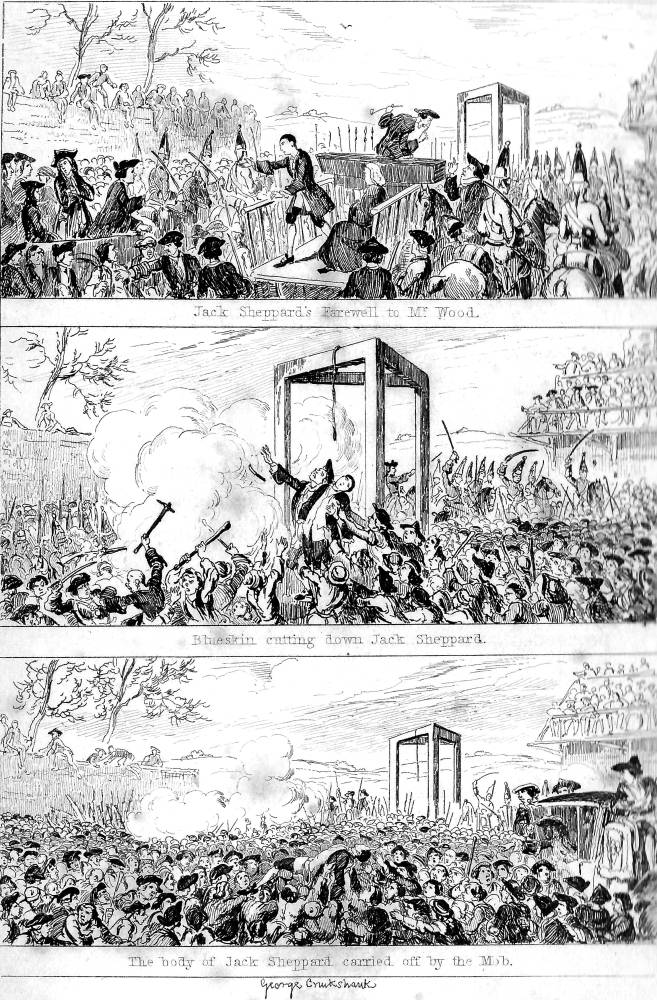
The Last Scene: engravings by George Cruikshank to illustrate the serialised novel Jack Sheppard by William Harrison Ainsworth, published in Bentley's Miscellany from January 1839; the captions read: "Jack Sheppard's Farewell to Mr Wood", "Blueskin cutting down Jack Sheppard", and "The body of Jack Sheppard carried off by the mob".
Scene from The Beggar's Opera: print by John Doyle, b&w, 31 x 45 cm, published by Thos. McLean, 26 Haymarket, London, 15 December (Tabley House Collection Trust, University of Manchester / British Cartoon Archive, University of Kent)
Scene from The Beggar's Opera: print by John Doyle, b&w, 31 x 45 cm, published by Thos. McLean, 26 Haymarket, London, 14 April 1841 (Tabley House Collection Trust. University of Manchester / British Cartoon Archive, University of Kent)
Scene from The Beggar's Opera: print by John Doyle, b&w, 31 x 45 cm, published by Thos. McLean, 26 Haymarket, London, 8 April 1841 (Tabley House Collection Trust, University of Manchester / British Cartoon Archive, University of Kent)
The Beggar's Opera: print after William Hogarth (1697-1764), b & w, 58 x 45 cm, published by G. & J. Robinson, Paternoster Lane, London, 8 April 1841 (University of Manchester / British Cartoon Archive, University of Kent)

Old Bailey: drawing by Thomas Rowlandson and Augustus Pugin, aquatinting by Joseph Stadler, from Ackermann's Microcosm of London, 1808

Newgate Chapel: drawing by Thomas Rowlandson and Augutus Pugin, auatinting by J. Bluck, from Ackermann's Microcosm of London, 1808
Newgate took its name from one of the gates of the City of London. It was the jail for the most serious criminals. According to William Pyne, author of the Microcosm of London (1808), on the Sunday before the condemned were scheduled to die, the 'Ordinary' (the clergyman) of Newgate preached a special sermon in the jail's chapel. A black coffin would be placed on a table in the centre of the chapel (known as the dock). Those condemned to die sat immediately around the coffin.
The political activist, Francis Place, described his experience of visiting Newgate Prison in the mid-1790s:
"In 1794 I was several times in Newgate on visits to persons confined for libel & c. -- one Sunday in particular I was there when several respectable women were also there -- relatives of those I went to see. When the time for leaving the prison arrived we came in a body of nine or ten persons into a large yard which we had to cross -- into this yard a number of felons were admitted and they were in such a condition that we were obliged to request the jailer to compel them to tie up their rags so as conceal their bodies which were most indecently exposed and was I have no doubt intentional to alarm the women and extort money from the men. When they had made themselves somewhat decent we came into the yard, and were pressed upon and almost hussled by the felons whose arms and voices demanding money made a frightful noise and alarmed the women. I who understood these matters collected all the halfpence I could and by throwing a few at a time over the heads of the felons set them scrambling swearing all but fighting whilst the women and the rest made their way as quickly as possible across the yard." (British Library, Add. MS. 27,826, Place papers. Vol.XXXVIII: Manners and Morals, vol.II', fol.186)

The pillory at Charing Cross: hand-coloured aquatint printed by John Bluck after drawing by Thomas Rowlandson and Augustus Pugin for Ackermann's Microcosm of London, 1809

The permanent gallows at Tyburn, which stood where Marble Arch now stands. Executions at this site necessitated a three-mile cart ride in public from Newgate prison to the gallows. Huge crowds collected on the way and followed the accused to Tyburn. These were used as the gallows for London offenders from the 16th century until 1759. Note the size of this structure: about 4 metres tall, it was capable of hanging nine people at a time. The victim was led up to the gallows on a cart, put in the noose and the cart driven away, Here Jack Sheppard, aka "Gentleman Jack", notorious thief and multiple escapee, and allegedly the "original" of John Gay's Captain Macheath in The Beggar's Opera, was hanged 16 November 1724: author unknown, c. 1680 (UK National Archives)
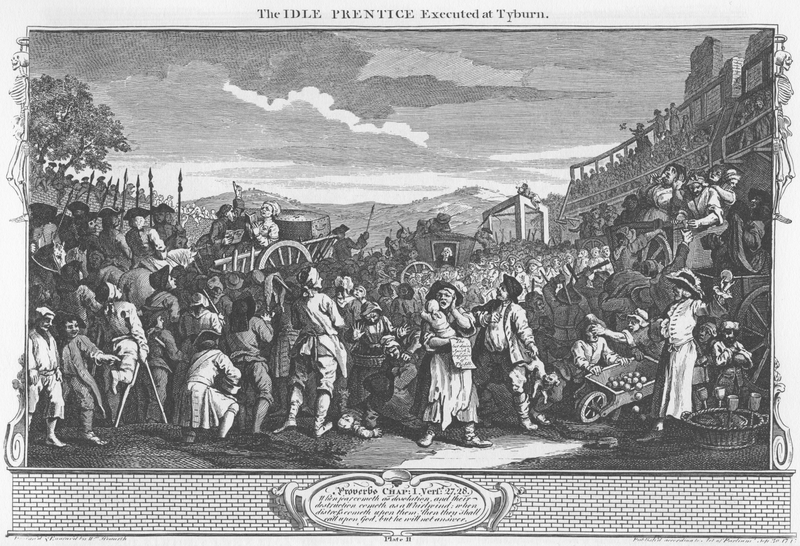
The Idle Prentice executed at Tyburn: William Hogarth (1697-1764), plate 11 in Industry and Idleness (from Hogarth's Graphical Works)
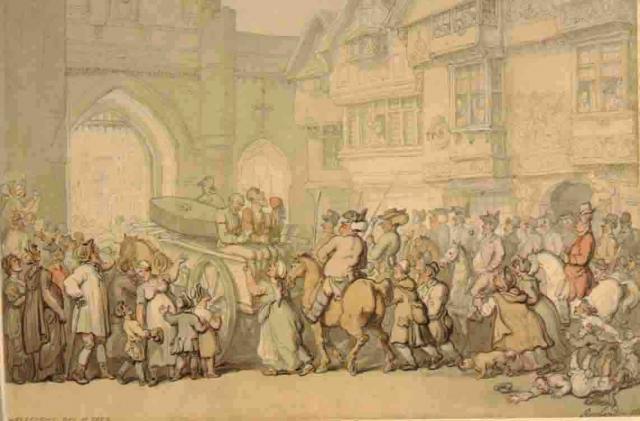
Execution Day at York: Thomas Rowlandson, c. 1820 (York Art Gallery)
The manner of execution at Tyburn: author unknown, late 17th century

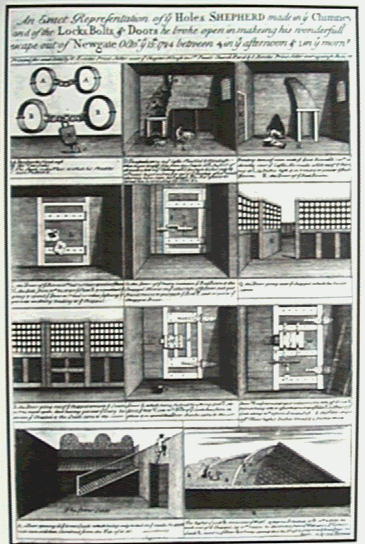


No comments:
Post a Comment